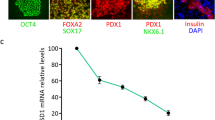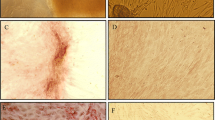Abstract
Diabetes is a worldwide health problem with increasing incidence. The current management modalities did not succeed to decrease comorbidities. This study aimed at enhancing the regenerative solution for diabetes by improving the differentiation of mesenchymal stromal cells (MSC) into glucose-sensitive, insulin-secreting cells through an epigenetic modification approach. A 3-day treatment protocol with the epigenetic modifiers, either decitabine (5-aza-2′-deoxycytidine; Aza); a DNA methylation inhibitor or Vorinostat (suberoylanilide hydroxamic acid; SAHA); a histone deacetylase inhibitor was added to two different human stem cell lines. The cells followed a multi-step differentiation protocol that provided the critical triggers in a temporal approach. Aza-pretreated group showed higher intracellular expression of insulin and the transcription factor ‘PDX-1’. The cells responded to the high glucose challenge by secreting insulin in the media, as shown by ELISA. Gene expression showed induction of the genes for insulin, the glucose transporter 2, glucokinase, as well as the transcription factors MafA and NKX6.1. Although SAHA showed upregulation of insulin secretion, in comparison to control, the cells could not respond to the high glucose challenge. Interestingly, Aza-treated cells showed a significant decrease in the global DNA methylation level at the end of the culture. In conclusion, this additional step with Aza could enhance the response of MSC to the classical differentiation protocol for insulin-secreting cells and may help in establishing a regenerative solution for patients with diabetes.




Similar content being viewed by others
References
Patterson CC, Dahlquist GG, Gyürüs E, Green A, Soltész G. Incidence trends for childhood type 1 diabetes in Europe during 1989–2003 and predicted new cases 2005–20: a multicentre prospective registration study. Lancet. 2009;373(9680):2027–33. https://doi.org/10.1016/s0140-6736(09)60568-7.
Robertson RP. Islet transplantation for type 1 diabetes, 2015: what have we learned from alloislet and autoislet successes? Diabetes Care. 2015;38(6):1030–5. https://doi.org/10.2337/dc15-0079.
Siskind E, Maloney C, Jayaschandaran V, Kressel A, Akerman M, Shen A, et al. Pancreatic retransplantation is associated with poor allograft survival. Pancreas. 2015;44(5):769–72. https://doi.org/10.1097/mpa.0000000000000330.
Siskind E, Akerman M, Maloney C, Huntoon K, Alex A, Siskind T, et al. Pancreas transplantation from donors after cardiac death. Pancreas. 2014;43(4):544–7. https://doi.org/10.1097/mpa.0000000000000084.
Chhabra P, Brayman KL. Stem cell therapy to cure type 1 diabetes: from hype to hope. Stem Cells Transl Med. 2013;2(5):328–36. https://doi.org/10.5966/sctm.2012-0116.
Pittenger MF. Multilineage potential of adult human mesenchymal stem cells. Science. 1999;284(5411):143–7. https://doi.org/10.1126/science.284.5411.143.
Kushner JA, MacDonald PE, Atkinson MA. Stem cells to insulin secreting cells: two steps forward and now a time to pause? Cell Stem Cell. 2014;15(5):535–6. https://doi.org/10.1016/j.stem.2014.10.012.
Gabr MM, Zakaria MM, Refaie AF, Khater SM, Ashamallah SA, Ismail AM, et al. Generation of insulin-producing cells from human bone marrow-derived mesenchymal stem cells: comparison of three differentiation protocols. Biomed Res Int. 2014;2014:1–9. https://doi.org/10.1155/2014/832736.
Hrvatin S, O’Donnell CW, Deng F, Millman JR, Pagliuca FW, DiIorio P, et al. Differentiated human stem cells resemble fetal, not adult, β cells. Proc Natl Acad Sci. 2014;111(8):3038–43. https://doi.org/10.1073/pnas.1400709111.
Pagliuca FW, Millman JR, Gürtler M, Segel M, Van Dervort A, Ryu JH, et al. Generation of functional human pancreatic β cells in vitro. Cell. 2014;159(2):428–39. https://doi.org/10.1016/j.cell.2014.09.040.
Ryall JG, Cliff T, Dalton S, Sartorelli V. Metabolic reprogramming of stem cell epigenetics. Cell Stem Cell. 2015;17(6):651–62. https://doi.org/10.1016/j.stem.2015.11.012.
Christensen DP, Dahllof M, Lundh M, Rasmussen DN, Nielsen MD, Billestrup N, et al. Histone deacetylase (HDAC) inhibition as a novel treatment for diabetes mellitus. Mol Med. 2011;17(5–6):378–90. https://doi.org/10.2119/molmed.2011.00021.
Chen X, Hu C, Zhang W, Shen Y, Wang J, Hu F, et al. Metformin inhibits the proliferation, metastasis, and cancer stem-like sphere formation in osteosarcoma MG63 cells in vitro. Tumour Biol. 2015;36(12):9873–83. https://doi.org/10.1007/s13277-015-3751-1.
Locklin RM, Oreffo RO, Triffitt JT. Modulation of osteogenic differentiation in human skeletal cells in Vitro by 5-azacytidine. Cell Biol Int. 1998;22(3):207–15. https://doi.org/10.1006/cbir.1998.0240.
Sengers BG, Please CP, Oreffo RO. Experimental characterization and computational modelling of two-dimensional cell spreading for skeletal regeneration. J R Soc Interface. 2007;4(17):1107–17. https://doi.org/10.1098/rsif.2007.0233.
El-Serafi AT, Oreffo RO, Roach HI. Epigenetic modifiers influence lineage commitment of human bone marrow stromal cells: differential effects of 5-aza-deoxycytidine and trichostatin A. Differentiation. 2011;81(1):35–41. https://doi.org/10.1016/j.diff.2010.09.183.
Gao F, Wu DQ, Hu YH, Jin GX, Li GD, Sun TW, et al. In vitro cultivation of islet-like cell clusters from human umbilical cord blood-derived mesenchymal stem cells. Transl Res. 2008;151(6):293–302. https://doi.org/10.1016/j.trsl.2008.03.003.
Sakata N, Egawa S, Sumi S, Unno M. Optimization of glucose level to determine the stimulation index of isolated rat islets. Pancreas. 2008. https://doi.org/10.1097/mpa.0b013e31815ccad2.
Matsuzaki Y, Umemoto T, Tanaka Y, Okano T, Yamato M. beta 2-microglobulin is an appropriate reference gene for RT-PCR-based gene expression analysis of hematopoietic stem cells. Regen Ther. 2015;1:91–7. https://doi.org/10.1016/j.reth.2015.04.003.
Livak KJ, Schmittgen TD. Analysis of relative gene expression data using real-time quantitative PCR and the 2(-Delta Delta C(T)) Method. Methods. 2001;25(4):402–8. https://doi.org/10.1006/meth.2001.1262.
Liu H, Guo D, Ruzi A, Chen Y, Pan T, Yang F, et al. Testosterone improves the differentiation efficiency of insulin-producing cells from human induced pluripotent stem cells. PLoS One. 2017;12(6):e0179353. https://doi.org/10.1371/journal.pone.0179353.
Ohtsubo K, Chen MZ, Olefsky JM, Marth JD. Pathway to diabetes through attenuation of pancreatic beta cell glycosylation and glucose transport. Nat Med. 2011;17(9):1067–75. https://doi.org/10.1038/nm.2414.
Lenz A, Toren-Haritan G, Efrat S. Redifferentiation of adult human beta cells expanded in vitro by inhibition of the WNT pathway. PLoS One. 2014;9(11):e112914. https://doi.org/10.1371/journal.pone.0112914.
Stepniewski J, Kachamakova-Trojanowska N, Ogrocki D, Szopa M, Matlok M, Beilharz M, et al. Induced pluripotent stem cells as a model for diabetes investigation. Sci Rep. 2015;5:8597. https://doi.org/10.1038/srep08597.
Vukic M, Neme A, Seuter S, Saksa N, de Mello VD, Nurmi T, et al. Relevance of vitamin D receptor target genes for monitoring the vitamin D responsiveness of primary human cells. PLoS One. 2015;10(4):e0124339. https://doi.org/10.1371/journal.pone.0124339.
Dave S. Extrinsic factors promoting insulin producing cell-differentiation and insulin expression enhancement-hope for diabetics. Curr Stem Cell Res Ther. 2013;8(6):471–83. https://doi.org/10.2174/1574888X113089990056.
Kornicka K, Marycz K, Marędziak M, Tomaszewski KA, Nicpoń J. The effects of the DNA methyltranfserases inhibitor 5-Azacitidine on ageing, oxidative stress and DNA methylation of adipose derived stem cells. J Cell Mol Med. 2017;21(2):387–401. https://doi.org/10.1111/jcmm.12972.
Zhou Y, Mack DL, Williams JK, Mirmalek-Sani S-H, Moorefield E, Chun S-Y, et al. Genetic modification of primate amniotic fluid-derived stem cells produces pancreatic progenitor cells in vitro. Cells Tissues Organs. 2013;197(4):269–82. https://doi.org/10.1159/000345816.
El-Serafi AT, Sandeep D, Abdallah S, Lozansson Y, Hamad M, Khan AA. Paradoxical effects of the epigenetic modifiers 5-aza-deoxycytidine and suberoylanilide hydroxamic acid on adipogenesis. Differentiation. 2019;106:1–8. https://doi.org/10.1016/j.diff.2019.02.003.
El-Serafi AT. Epigenetic modifiers and stem cell differentiation. In: Hayat M, editor. Stem cells and cancer stem cells. Dordrecht: Springer; 2012. p. 147–54.
El-Serafi A. Epigenetic modifiers as an additive to stem cells differentiation protocols. J Stem Cells Res Rev Rep. 2017;4:1024.
Kaminskas E, Farrell AT, Wang YC, Sridhara R, Pazdur R. FDA drug approval summary: azacitidine (5-azacytidine, Vidaza) for injectable suspension. Oncologist. 2005;10(3):176–82. https://doi.org/10.1634/theoncologist.10-3-176.
Mann BS, Johnson JR, Cohen MH, Justice R, Pazdur R. FDA approval summary: vorinostat for treatment of advanced primary cutaneous T-cell lymphoma. Oncologist. 2007;12(10):1247–52. https://doi.org/10.1634/theoncologist.12-10-1247.
Tiernan AR, Champion JA, Sambanis A. Trichostatin A affects the secretion pathways of beta and intestinal endocrine cells. Exp Cell Res. 2015;330(1):212–21. https://doi.org/10.1016/j.yexcr.2014.09.031.
Yamato E. High dose of histone deacetylase inhibitors affects insulin secretory mechanism of pancreatic beta cell line. Endocr Regul. 2018;52(1):21–6. https://doi.org/10.2478/enr-2018-0004.
Elsharkawi I, Sandeep D, El-Serafi A. Investigating the role of the histone deacetylases-inhibitor suberanilohydroxamic acid in the differentiation of stem cells into insulin secreting cells. Hamdan Med J. 2019;12:1–14.
Stresemann C, Lyko F. Modes of action of the DNA methyltransferase inhibitors azacytidine and decitabine. 2008.
Micallef SJ, Janes ME, Knezevic K, Davis RP, Elefanty AG, Stanley EG. Retinoic acid induces Pdx1-positive endoderm in differentiating mouse embryonic stem cells. Diabetes. 2005;54(2):301–5. https://doi.org/10.2337/diabetes.54.2.301.
Zheng Y. G protein control of microtubule assembly. Annu Rev Cell Dev Biol. 2004;20:867–94. https://doi.org/10.1146/annurev.cellbio.20.012103.094648.
Edlund H. Pancreatic organogenesis—developmental mechanisms and implications for therapy. Nat Rev Genet. 2002. https://doi.org/10.1038/nrg841.
Gu G, Dubauskaite J, Melton DA. Direct evidence for the pancreatic lineage: NGN3+ cells are islet progenitors and are distinct from duct progenitors. Development (Cambridge, England). 2002. https://doi.org/10.1146/annurev.cellbio.20.012103.094648.
Zhao Q, Yang Y, Hu J, Shan Z, Wu Y, Lei L. Exendin-4 enhances expression of Neurod1 and Glut2 in insulin-producing cells derived from mouse embryonic stem cells. Arch Med Sci. 2016. https://doi.org/10.5114/aoms.2016.57596.
Taylor BL, Liu FF, Sander M. Nkx6.1 is essential for maintaining the functional state of pancreatic beta cells. Cell Rep. 2013;4(6):1262–75. https://doi.org/10.1016/j.celrep.2013.08.010.
Eto K, Nishimura W, Oishi H, Udagawa H, Kawaguchi M, Hiramoto M, et al. MafA is required for postnatal proliferation of pancreatic β-cells. PLoS One. 2014;9(8):e104184. https://doi.org/10.1371/journal.pone.0104184.
Bonal C, Herrera PL. Genes controlling pancreas ontogeny. Int J Dev Biol. 2008;52(7):823–35. https://doi.org/10.1387/ijdb.072444cb.
Kuroda A, Rauch TA, Todorov I, Ku HT, Al-Abdullah IH, Kandeel F, et al. Insulin gene expression is regulated by DNA methylation. PLoS One. 2009;4(9):e6953. https://doi.org/10.1371/journal.pone.0006953.
Yang JJ, Wang XL, Shi BW, Huang F. The angiogenic peptide vascular endothelial growth factor-basic fibroblast growth factor signaling is up-regulated in a rat pressure ulcer model. Anat Rec (Hoboken). 2013;296(8):1161–8. https://doi.org/10.1002/ar.22676.
Ishikawa K, Tsunekawa S, Ikeniwa M, Izumoto T, Iida A, Ogata H, et al. Long-term pancreatic beta cell exposure to high levels of glucose but not palmitate induces DNA methylation within the insulin gene promoter and represses transcriptional activity. PLoS One. 2015;10(2):e0115350. https://doi.org/10.1371/journal.pone.0115350.
Acknowledgements
This study was funded by Sheikh Hamdan Bin Rashid Al Maktoum Award for Medical Sciences (Grant no.: MRG-6112013-2014). The laboratory infrastructure and personnel were supported by the University of Sharjah, UAE.
Author information
Authors and Affiliations
Corresponding author
Ethics declarations
Conflict of interest
The authors declare no conflict of interest.
Additional information
Publisher's Note
Springer Nature remains neutral with regard to jurisdictional claims in published maps and institutional affiliations.
Rights and permissions
About this article
Cite this article
Elsharkawi, I., Parambath, D., Saber-Ayad, M. et al. Exploring the effect of epigenetic modifiers on developing insulin-secreting cells. Human Cell 33, 1–9 (2020). https://doi.org/10.1007/s13577-019-00292-y
Received:
Accepted:
Published:
Issue Date:
DOI: https://doi.org/10.1007/s13577-019-00292-y




